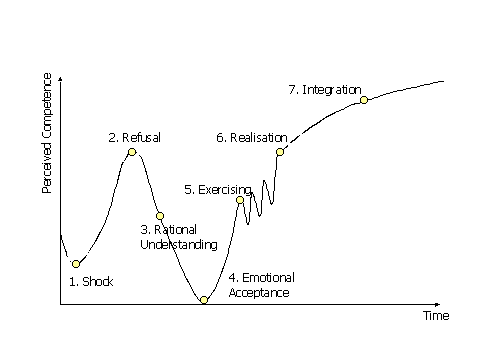Organizational change can be defined as the process of “Leading people on a different path than what they are accustomed to.” (Definition of organizational change 2009). It is essential to have changes in any organization, but it is more important to have a successful change. The change becomes successful when it contributes to the success of the organization. The key forces leading to organizational change may be both internal and external in origin. Organizational development or OD is a key term for managing organizational change. Organizational development is a skeleton of planned change interventions leading to organizational effectiveness. The major reasons for the barrier to organizational change are the lack of proper training and employee resistance towards the change. Most of the employees have a negative reaction towards the change as they fear the loss of job, social status, and security.
“Change management means to plan, initiate, realize, control, and finally stabilize change processes on both, corporate and personal level.” (Reckless n.d.). A change is caused due to the changing external conditions and relatively adapting to those conditions. There can be seven stages in people’s perception of change. These stages can be represented as:

(Reckless n.d.). Only by passing through all these stages and analyzing the same, one can successfully handle the organizational change. The factors that pave the way to the growing and changing conditions in organizations are mergers, acquisitions, restructuring, new technology, and downsizing. Organizational change is inevitable in any organization and the skills needed to manage and lead the change successfully lies in the fact of understanding the human factors and then managing it. There can be various reactions and attitudes from the employees regarding a change occurred or occurring, the anxiety of not knowing the fact that stretches out ahead can create stress or resistance in their behavior. When an employee hears of a change to be implemented, he usually has a shock. Instead of this reaction, the employee must analyze exactly the benefits and harmful effects that can be caused by the change. If the employees take the changes to their level, those will surely be threatening for them. The managers understanding this behavior can talk with them and motivate them by explaining the benefits of the change. A good, efficient manager must always think about the change from the employees’ shoes and should get the responses. The reactions to a change may be either positive or negative. As the majority of the employees will have a negative attitude, it may result in absenteeism, low productivity, high stress level, etc. Hence, managing organizational change is very important in every organizational setup. The steps to be taken care of should be that the employees should be open-minded, should stay flexible, should support other colleagues, take an active role in the change process, and give a chance for the change to perform. Thus, change management can be done successfully.
“If you don’t like change, you’re going to like irrelevance even less.” (A dislike for change 2009). Every individual has a limit for how much they can withstand change. And hence some employees will resist the change due to their dislike or fear. Even when the employees get ready to manage change, the uncertainty level of risk and fear may block them from taking a chance to manage change. The majority of the change situations fail because of the fear that the employees have towards change. This fear may be due to the dislike of the change; hence they show resistance towards the change. This dislike arises due to the gap between the strategic vision and the successful change implementation and also due to the lack of change management models in the organizations. If a successful change management tool is implemented in the organization or if counseling is provided for the employees about the beneficial part of the changes taking place, those employees will try to take a chance in change management. Only through these two ways, the dislike of change can be prevented and successful change management can be incorporated. Dislike of change can be a major reason for change resistance even though there are many other reasons. Hence steps should be taken to prevent this change resistance behavior.
Reference List
A dislike for change 2009, Fast Company.
Definition of organizational change: learning, performance and training definitions 2009, Babylon.
Recklies, O n.d., Managing change- definition und phases in change processes: definition, Themanager.org.
Recklies, O n.d., Managing change- definition und phases in change processes: phase in change processes, Themanager.org.